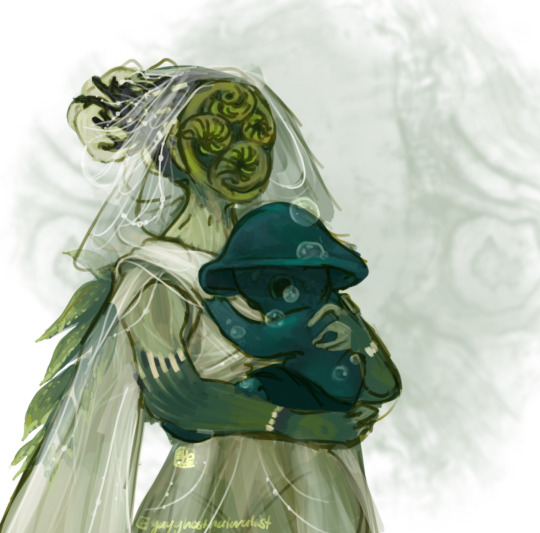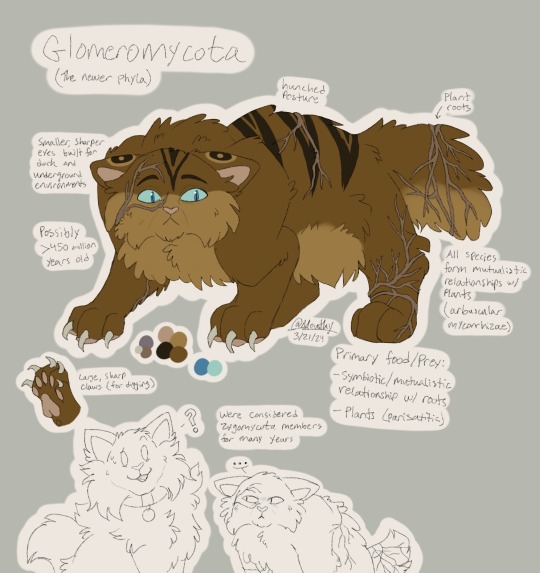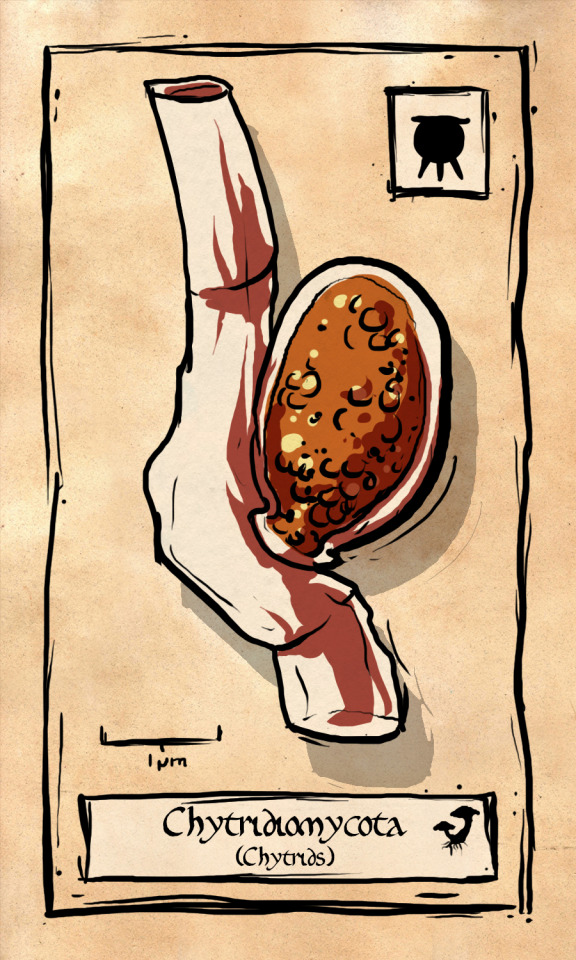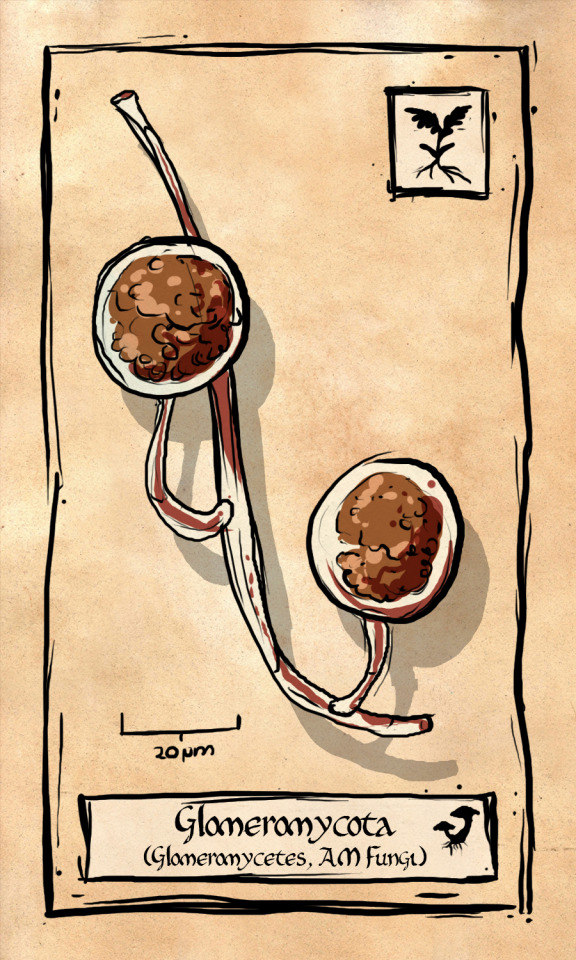#glomeromycota
Explore tagged Tumblr posts
Text


My lichen boy as a very little baby, he’s a old god of old Ascomycetes and almost all lichen fall in that division. Lichens are interesting because it’s not a heritage thing it’s more like a lifestyle choice. The ability to lichenize has been gained and lost several times. I read a paper that changed the emergence of lichens after crown tracheophytes (vascular plants, like ferns, horsetails etc) and I pictured his sister division, Glomeromycota sort of bringing him to land. Glomeromycetes are mycorrhizal and can kind of be… assholes about it. They can hoard everything and might force a symbiosis which is interesting. Um, yeah. I have more art for them floating around my blog.
#botany worldbuilding#boy#lichen#ascomycota#lichen creatures#old god#summon an old god they said#ttrpg art#ttrpg homebrew#fungi#glomeromycota#botany in fantasy#my oc#character design#botany#art#artists on tumblr#scientists#ferns#horsetails#moss
41 notes
·
View notes
Text

The plant root guy
#cat art#cat#warrior cats#warrior cat art#warriors au#warrior cats art#biology#catified#fungi#fungus#glomeromycota#fungus cats#phylum#mushrooms#mold#mushroom spores
3 notes
·
View notes
Text
The fungal partner in these arbuscular mycorrhizal associations belongs to the ancient phylum Glomeromycota, which has lost the ability to complete its life cycle outside the plant.
"Plant Physiology and Development" int'l 6e - Taiz, L., Zeiger, E., Møller, I.M., Murphy, A.
#book quote#plant physiology and development#nonfiction#textbook#fungus#arbuscular mycorrhizae#mycorrhizal network#mycorrhizal fungi#glomeromycota#life cycle
0 notes
Text
Genuinely just looked at pictures of Arbuscular Mycorrhizal Fungi for motivation.
#the fungi truly have consumed me#they are also AMFs if you are cool#Glomeromycota is the phylum#I love them dearly you should check them out#call me patient zero the way fungi have consumed my mind#fungus
0 notes
Text
kingdom winner: FUNGI!!
#polls#tumblr polls#poll#living creature poll#mushroom#fungi#chytrid#mold#soil fungi#sac fungi#hyphae#should i tag the last of us as a joke?#nah that'd just be cruel#also basidiomycota are just most regular mushrooms#and yes for all you biology nerds i did skip over glomeromycota since there was no good definition for it#mycology
0 notes
Text
Hey folks! Any of you well-versed on fungi taxonomy? Me and Eddie are researching fungi phyla, and it is (naturally) a fluid mess! We've run into some very specific problems... Most of our sources indicate that Glomeromycota is a complete phylum, but a study from 2016 claims it is merely a subphylum under Mucoromycota? We don't know what to think! Help!?
39 notes
·
View notes
Text
Concept Idea #01 | Research - Types of Mycorrhizal Fungi
Types of Mycorrhizal Fungi:
Arbuscular Mycorrhizal Fungi (AMF): These fungi (from the phylum Glomeromycota) penetrate plant root cells, forming tiny tree-like structures called arbuscules inside the roots. They are the most common type of mycorrhizae.

Ectomycorrhizal Fungi: These fungi (from the phyla Basidiomycota and Ascomycota) form a sheath around plant roots and extend into the soil with their hyphae. They don't go inside the root cells but still help the plant get nutrients.

Strigolactones: These are plant hormones released by the roots into the soil. They act as a calling card for the fungi to come to the tree.

Myc Factors: These are molecules produced by the fungi in response to strigolactones. They help the plant recognize the fungi and start the symbiotic relationship.
Phosphorus and Nitrogen Uptake: The fungi’s hyphae are like long fingers that reach out into the soil to grab nutrients like phosphorus and nitrogen and bring them back to the plant. The fungi’s hyphae also help hold the soil together, preventing it from washing away during heavy rains.

Carbon Transfer: The plant makes sugar from sunlight through photosynthesis and shares some of this sugar with the fungi as a reward for their help.
Antibiotic Production: Some fungi produce substances that act like natural antibiotics, protecting the plant roots from harmful germs.
.
All these different types of Mycorrhizal Fungi i've mentioned above could be turned into tiny characters doing different jobs in my illustration. The roots and fungi talking to each other is like having tiny helpers underground that make sure plants stay healthy, grow well, and share their food with each other. This helps make forests and farms better and keeps the soil full of nutrients. And I could illustrate this entire process through translating this into a world with its own tiny characters with very important jobs.
0 notes
Text

Sketch of Cyphe! I just had my unit on mineralogy and wanted to do more earth genasi stuff. She’s based on agate, and her scars are opal.
And. Some fungi. She has a curse (chronic illness) and the necromancy is bringing out fungi, specifically glomeromycota, the arbuscular mycorrhizal fungi. Arbuscules form within the plant cell, the same thing is happening to her. These are based on fungi on agar plates.
#earth genasi#dnd art#character design#illustration#artists on tumblr#art#dnd#concept art#Cyphe#cyphelium evernia minarum nephrite#she’s a paleobotanist#a necromancer for plants!
26 notes
·
View notes
Text








The fungi are perhaps the most alien kingdom to those of us in kingdom Animalia. With their many strange and incredible lifestyles, differing life cycles, and vastly different appearances, this kingdom features an incredible variety of species. Overall the Fungi cards are themed with very large but nebulous concepts, one should look to complex and interconnected overall changes, needs, and states when Fungi cards are in the reading. These are concepts beyond those that are immediate to life and are more universal in nature.
Ascomycota – The Yeast card represents transmogrification, a transformation of one thing into another. While literal change can be seen with metamorphosis, when in a card reading one should look to metaphorical transformation, mental, physical, or emotional, either in the past which may be affecting the present, or to be seen in and embraced in the future. One should not fear change, as fungi as a whole remind us it is inevitable. While Ascomycota encompass a vast variety of fungi, perhaps some of the most notable in the phyla are the yeasts which allow beer and bread to ferment. All fungi are transformative, but these are some of the most notable in our human, everyday lives.
Basidiomycota – The Mushroom card is renewal in its most fundamental state. Beyond death there is decay, from decay there is life. Despite difficulty, tragedy, or death there is promise of renewed life and vitality. Despite vitality, there is always the promise of death. In life there is death. In death there is life. In reading this must be considered with the subject and surrounding circumstance, but a reminder of death is always prudent, and a reminder that it brings life is all the more so. Within this Phylum are some of the most well known mushroom species, and they are the most visible signs of life renewed from death to the human eye. Their interlinked nature to all things that live is a constant reminder that decay is an extant form of life.
Blastocladiomycota – The Blastoclad card represents minutia. The smallest things which are often below notice and require a narrowed and careful view to ascertain. Is there something large ahead which seems insurmountable? Perhaps it is time to look smaller. It could also be that assessment of the smaller things could prove better to create a better working whole. Only recently defined within their own phylum, blastoladiomycota are defined by the ultrastructure of their zoospores, defining their reproduction on a cellular as physically unique among all phyla.
Chytridiomycota – The Chytrid card represents cooking. More than just transforming from one state to another, cooking requires the input of various ingredients and the application of outside sources of energy to see something to a desirable conclusion. If something is not moving forward, it may be time to reconsider what elements are needed for it to improve. Think of where the recipe has deviated or is lacking, and look to apply outside stimulus to the subject of the reading. The name for this phylum derives from the Greek 'little cooking pot' referring to the structure of unreleased zoospores.
Glomeromycota – The Mycorrhizal Fungi card represents growth. To grow is to move beyond what is past and to continue to change and adapt. Growth can be large or small, but it is ever present. Consider in the reading that it may be time to focus on growth. Critical to life on earth, mycorrhizal fungi support the growth of many keystone plant species, which would be unable to thrive without them. Without the plants, ecosystems would collapse. Their existence is absolutely critical to the growth of nearly all plant life on earth.
Microsporidia – The Microsporadia card represents control. In a reading one should consider where control of a situation or thing has been lost, and where it might be regained, refined, or better understood. The overt control of a situation may not be possible, but one can look to elements they can control and act within their own best interest. Control, when left unchecked, can be dangerous and detrimental to others, so it is best to consider the broad scope. Microsporidia are unicellular fungi and the phylum contains a number of parasites capable of controlling various aspects of their host's morphology and biology.
Neocallimastigomycota – The Neocallimastigomycete card represents rumination, or gentle, introspective thought and digestion of complex and hard matters. When coming upon a difficult issue or harsh reality it can be important to take the time to reflect on this and digest it piece by piece. As Neocallimastigomycetes exist in the offal of herbivorous animals and aid in digestion of tough plant matter, they too exist here to reflect upon the need to take the time to digest harsh matters, and allow whatever events that surround us to be taken apart piece by piece until it can be managed by the whole.
Zygomycota – The Zygomycete card represents a pair, or a duality. There is a natural fascination in the human mind for twins, it is unusual for our species, and therefore comes across as something special. Things that are paired are of a natural interest, and one should remark their uniqueness. When one of a pair is missing, it is natural to hurt for its loss, and to look for its replacement. Consider what is missing, and what is lost, and look to find a match to complete it. The name of this phylum refers to the specific visual appearance of the zygosporangia (spores) formed during sexual reproduction, which appear as two fused but distinct cells.
17 notes
·
View notes
Photo










Sun Church Ruins, Sweden (No. 8)
In American English, "lichen" is pronounced the same as the verb "liken". In British English, both this pronunciation and one rhyming with "kitchen" are used. English lichen derives from Greek λειχήν leichēn ("tree moss, lichen, lichen-like eruption on skin") via Latin lichen. The Greek noun, which literally means "licker", derives from the verb λείχειν leichein, "to lick".
Like the word moss, the word lichen is also used as an uncountable noun, as in "Lichen grows on rocks".
Lichens are classified by the fungal component. Lichen species are given the same scientific name (binomial name) as the fungus species in the lichen. Lichens are being integrated into the classification schemes for fungi. The alga bears its own scientific name, which bears no relationship to that of the lichen or fungus. There are about 13,500–17,000 identified lichen species. Nearly 20% of known fungal species are associated with lichens.
"Lichenized fungus" may refer to the entire lichen, or to just the fungus. This may cause confusion without context. A particular fungus species may form lichens with different algae species, giving rise to what appear to be different lichen species, but which are still classified (as of 2014) as the same lichen species.
Formerly, some lichen taxonomists placed lichens in their own division, the Mycophycophyta, but this practice is no longer accepted because the components belong to separate lineages. Neither the ascolichens nor the basidiolichens form monophyletic lineages in their respective fungal phyla, but they do form several major solely or primarily lichen-forming groups within each phylum. Even more unusual than basidiolichens is the fungus Geosiphon pyriforme, a member of the Glomeromycota that is unique in that it encloses a cyanobacterial symbiont inside its cells. Geosiphon is not usually considered to be a lichen, and its peculiar symbiosis was not recognized for many years. The genus is more closely allied to endomycorrhizal genera. Fungi from Verrucariales also form marine lichens with the brown algae Petroderma maculiforme, and have a symbiotic relationship with seaweed (such as rockweed) and Blidingia minima, where the algae are the dominant components. The fungi is thought to help the rockweeds to resist desiccation when exposed to air. In addition, lichens can also use yellow-green algae (Heterococcus) as their symbiotic partner.
Lichens independently emerged from fungi associating with algae and cyanobacteria multiple times throughout history.
Source: Wikipedia
#Sun Church Ruins#Sunne kyrkoruin#Sunne#Sunne Church#architecture#ruins#overgrown#lichen#tree#nature#wildflower#blooming#flora#fireweed#I love places like this#so much to explore#summer 2020#travel#vacation#Östersund Municipality#Jämtland County#Sweden#Sverige#tourist attraction#landmark#free admission#original photography#Scandinavia#Northern Europe
4 notes
·
View notes
Text
dude tries to assert that dickinsonia ≠ animal because glomeromycota don’t produce ergosterol either and also produce cholesterol but author of the paper writes back to point out that glomeromycota don’t ACTUALLY contain cholesterol because the compound 24-ethyl cholesterol is actually a c29 sigmasteroid that is not produced by dickinsoniids ABDJAHHD
1 note
·
View note
Note
hi cody <3 the fruit fly is back to buzz except with an account <3 making this your problem from this point forward
Finally i can send you all these supernatural posts i keep seeing on my dash in a desperate grasp for answers about what in da hell any of them mean. thank you for your service
#hiii morgan hi hiiiiii#morgan phrogtooth no longer#as for the follow back ? we’ll see#filler tags /::#s/://////:/#shdhhshd#;:):)/$:):)/(#heejjdhdd#glomeromycota#just in case. so this doesnt end up in the tag#dont want to piss off the glomeromycetes fans on here clogging their tag with fruits#asks
3 notes
·
View notes
Photo







The Ancestor’s Tale, Rendezvous 34: Fungi
Pin Mould Growth
youtube
#The Ancestor's Tale#Richard Dawkins#Rendezvous 34#Fungi#Microsporidians#Chytrids#Bread Mould#Pin Moulds#Zygomycota#Arbuscular Mycorrhizal Fungi#Glomeromycota#Club Fungi#Basidiomycota#Morels#Truffles#Ascomycota#Evolution#mike guether
0 notes
Photo

India Mucormycosis Treatment (Black Fungus Drugs) Market
India mucormycosis treatment (black fungus drugs) involves prescription antifungal medicine, such as isavuconazole, posaconazole, or amphotericin B. Isavuconazole and posaconazole can also be administered orally, while isavuconazole, posaconazole, and amphotericin B are given intravenously. Mucormycosis, also known as black fungus, is a fungal infection caused by a group of microorganisms belonging to the phylum Glomeromycota.
Read more @ https://digitalgrowinfo.blogspot.com/2022/04/the-outbreak-of-covid-19-has-increased.html
0 notes
Text
Why Mycorrhizal Fungi Important for Plants

Summary: The following blog gives brief information about the mycorrhizal fungi which help for organic growth of crops. Mycorrhizal fungi are beneficial soil microorganisms establishing mutualistic symbioses with the roots of the most important food for plants.
Mycorrhizal fungi account for about 10% of diagnosed fungal species, along with basically all the Glomeromycota and sizable fractions of the Ascomycota and Basidiomycota. Numerous distinct varieties of mycorrhizal associations exist, which includes arbuscular, ericoid, orchid and ectomycorrhiza. Even though arbuscular mycorrhiza developed first, ectomycorrhizal and orchid mycorrhizal fungi are the most speciose sorts, and every of these sorts arose from more than one independent evolutionary activities, observed by means of convergent evolution.
Mycorrhizal fungi are useful fungi growing in association with plant roots, and exist by taking sugars from flowers ‘in change’ for moisture and vitamins accrued from the soil by means of the fungal strands. The mycorrhizas greatly boom the absorptive location of a plant, performing as extensions to the root device.
Phosphorus is often in very quick supply in natural soils. While phosphorus is found in insoluble bureaucracy it would require a vast root system for a plant to satisfy its phosphorus requirements unaided. It is consequently notion that mycorrhizas are critical in accumulating this detail in uncultivated soils. Phosphorus-rich fertilisers are extensively used in cultivated ground and now not only reduce the want for this activity but are notion to truly suppress the mycorrhizas. Because of this it's far best no longer to use phosphorous rich fertilisers at the side of mycorrhizal fungi.
Mycorrhizal fungi are frequently seen in gardens however can be less powerful on frequently cultivated soils that have been heavily fertilised and manured. Use of fungicides also can inhibit mycorrhizal fungi. It is good gardening practice to apply the lowest possible amounts of manure, fertiliser, fungicides, and cultivation. This can now not most effective store gardener’s time and money, but additionally enables closer to defensive the environment.
Healthiest plants Transplanter feature and biodiversity of whole ecosystems, connect unrelated individual plant species, and function as a sink for atmospheric carbon dioxide. Due to the numerous advantages they offer to plant life, mycorrhizal fungi are now extensively used in natural agriculture, plant nurseries, and restoration of mine tailings to improve the increase of economically important species. The elements that power fungi to establish and preserve mycorrhizal institutions are severely critical to understanding their feature in governing biodiversity, nutrient biking, and plant nutrients but are nevertheless very poorly understood.
Whilst the economic and ecological value of plant- mycorrhizal interactions has been identified and understood as important from human and surroundings angle, interactions between fungi and endobacteria are actually on the frontier of know-how plant-mycorrhizal interactions. Fungal cells are massive among mycorrhizal fungi and that their dynamics may be crucial to improvement and feature of mycorrhizal associations. It was lately discovered that a few endobacterial genes are critical to the established order of mycorrhizal institutions and that endobacteria adjust the metabolic profile and growth of host fungi, such that without endobacteria fungi respond inappropriately to plant exudates.
Some varieties of mycorrhizal fungi, inclusive of orchid mycorrhizal fungi, are only facultatively associated with flora, allowing the potential to generate a miles wider array of fungi freed from endobacteria. Any such machine might facilitate an extensive variety of experiments elucidating the roles endobacteria play in affecting how fungi function in ecosystems and in interactions with their plant hosts.
Content Source: https://rootrescue.blogspot.com/2022/02/why-mycorrhizal-fungi-important-for-plants.html
#why mycorrhizal fungi#why mycorrhizal fungi important#why mycorrhizal fungi important for plants#mycorrhizal fungi
0 notes

